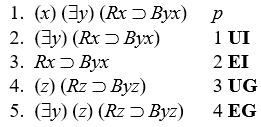Deck 11: Quantifier Rules Theory
Question
Question
Question
Question
Question
Question
Question
Question

Unlock Deck
Sign up to unlock the cards in this deck!
Unlock Deck
Unlock Deck
1/8
Play
Full screen (f)
Deck 11: Quantifier Rules Theory
1
Explain, using a concrete example, why we should not allow the following inference when using . What restriction then is required on the use of


It could allow us to move from a true statement to a false one. For example, if Lxy = "x loves y", then from the fact that x loves someone it does not follow that x loves him or herself. EI requires that the variable replacing the variable made free with the removal of the existential quantifier be one that is not free earlier in the proof (restriction 2).
2
Explain, using a concrete example, why we should not allow the following inference when using What restriction then is required on the use of


It could allow us to move from a true statement to a false one. For example, if Lxy = "x loves y", then from the fact that x loves someone it does not follow that x loves everyone. UG requires that the variable that is universally quantified be one that does not occur previously in a line obtained by EI (restriction 2)
3
Explain, using a concrete example, why we should not allow the following inference when using What restriction then is required on the use of


It could allow us to move from a true statement to a false one. For example, if Lxy = "x loves y", from the fact that someone loves someone it does not follow that anyone loves him or herself. EG requires that the variable that comes to be existentially quantified be one that does not already occur free in the formula we are quantifying.
4
Carefully explain why we forbid inferences like this one from line 2 to line 4:



Unlock Deck
Unlock for access to all 8 flashcards in this deck.
Unlock Deck
k this deck
5
Carefully explain why we forbid inferences like this one from line 1 to line 2:



Unlock Deck
Unlock for access to all 8 flashcards in this deck.
Unlock Deck
k this deck
6
Do the same for the inference from line 3 to line 4:



Unlock Deck
Unlock for access to all 8 flashcards in this deck.
Unlock Deck
k this deck
7
Suppose we require that in using and there should be a one-to-one correspondence between free u's in (. . .u. . .) and bound w's in  . What errors or omissions (incompleteness), if any, would result
. What errors or omissions (incompleteness), if any, would result
 . What errors or omissions (incompleteness), if any, would result
. What errors or omissions (incompleteness), if any, would result 
Unlock Deck
Unlock for access to all 8 flashcards in this deck.
Unlock Deck
k this deck
8
Suppose we similarly require that in using and there should be a one-to-one correspondence between bound w's in  and free u's in (. . .u. . .). What errors or omissions, if any, would result?
and free u's in (. . .u. . .). What errors or omissions, if any, would result?
 and free u's in (. . .u. . .). What errors or omissions, if any, would result?
and free u's in (. . .u. . .). What errors or omissions, if any, would result? 
Unlock Deck
Unlock for access to all 8 flashcards in this deck.
Unlock Deck
k this deck



